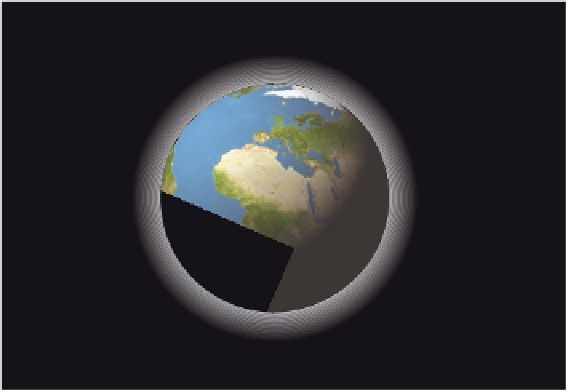Geoscience Reference
In-Depth Information
system, which is jointly administered by NASA, the National
Oceanic and Atmospheric Administration (NOAA), and the
U.S. Geological Survey (USGS). This satellite system is the
longest continuous Earth-observing project in history, begin-
ning with Landsat 1 in 1972 and continuing through the launch
of Landsat 8 in 2013. Landsat 8 orbits Earth at an altitude of
about 705 km (438 mi), has a swath width (it can “see”) of 185
km (115 mi), and returns to the point of origin every 16 days
(233 orbits). Landsat 8 carries two sensors: Operational Land
Imager (OLI) and Thermal Infrared Sensor (TIRS). OLI has
nine spectral bands, which means it can discriminate emit-
ted energy in several parts of the electromagnetic spectrum,
whereas the TIRS sensor has two spectral bands. The
spatial
resolution
of the various Landsat sensors ranges from 15 m
(49.2 ft) to 60 m (197 ft). Spatial resolution refers to the size
of the ground area that the sensor can “see” in detail. A 15-m
(49.2-ft) spatial resolution, for example, means that the satel-
lite can discern objects that are at least 15 m × 15 m in size.
Each of these 15 m × 15 m (49.2 ft × 49.2 ft) blocks is referred
to as a
pixel
.
In addition to the Landsat platform, another satellite with
a Sun-synchronous orbit is the Advanced Very High Resolution
Radiometer (AVHRR), which is managed by NOAA. This sat-
ellite orbits Earth 14 times per day from an altitude of 833 km
(517 mi) and has a spatial resolution that ranges between
1.1 km (0.7 mi) and 4 km (2.5 mi), depending on whether the
place viewed is directly below the satellite or on the fringe of
the area seen.
A
geostationary orbit
, in contrast to a Sun-synchronous
orbit, is designed to permanently remain in one place above
Earth. This consistent position is accomplished by placing the
satellite in an easterly orbit, directly over the Equator, and at
a very high altitude. The satellite orbits in the same direction
and at the same speed that Earth rotates. With such an orbit, the
satellite can view nearly half of Earth at any given time. This
kind of orbit is mostly used to observe weather and to facili-
tate communications. An excellent example of satellites with
a geostationary orbit is NOAA's Geostationary Operational
Environmental Satellites (GOES), which are used to monitor
meteorological conditions (Figure 2.23). This system consists
of an array of satellites that are positioned about 35,800 km
(22,300 mi) above Earth, high enough to allow very large re-
gions of Earth to be viewed at any given time. The GOES-12
(or GOES East) satellite, for example, is positioned above the
Equator at 75° W longitude and views most of North America,
all of South America, and most of the Atlantic Ocean. In
contrast, the GOES-10 (or GOES West) satellite is located
North Pole
Sun-synchronous
orbit 700-800 km high
Geosynchronous orbit
35,800 km high
South Pole
Figure 2.22 Sun-synchronous and geosynchronous satellite
orbits.
Sun-synchronous orbits are designed to keep pace with
the Sun's westward progress as Earth rotates. The orbit essen-
tially extends between the poles with a small inclination so that
the satellite moves slightly westward with each successive day.
Geosynchronous orbits hover over the same point on Earth, but
to do so, they must stay in a very high orbit over the Equator.
that continuously orbit Earth. These systems are designed for
either Sun-synchronous or geostationary orbits (Figure 2.22). A
satellite with a
Sun-synchronous orbit
has an orbit that keeps
pace with the Sun's westward progress as Earth rotates. Such a
position is maintained because the satellite's orbit is basically
north-south between the poles with a slight (8°) angular incli-
nation. As a result, a particular satellite may cross the Equator
12 times during the course of a day, with the local time perhaps
being 3:00 p.m. at the time of each pass. A Sun-synchronous or-
bit is usually at an altitude of about 700 km to 800 km (430 mi
to 500 mi).
The orbit of Sun-synchronous satellites results in large
gaps in image coverage between successive orbits on any given
day. Given the slight inclination of the orbit, however, the sat-
ellite progresses slightly westward with each new day. In this
way, the satellite slightly overshoots the orbital path from the
previous day, yielding imagery that overlaps a little so that no
information is lost. Because satellites with Sun-synchronous
orbits pass over the same part of Earth at about the same time
each day, they are particularly good for monitoring landscape
change over time.
Severalwell-knownsatellitesystemshaveSun-synchronous
orbits. Perhaps the best known of these satellites is the Landsat
Sun-synchronous orbit
A slightly inclined polar orbit that
keeps pace with the Sun's westward progress as Earth rotates,
resulting in regular return intervals over every location on
Earth.
Pixel
The smallest definable area of detail on an image; short
for pixel element.
Geostationary orbit
An orbit where satellites remain over the
same place on Earth every day. This orbit is achieved because
the satellite is placed very high above Earth and travels at the
same speed as the Earth's rotation.
Spatial resolution
The area on the ground that can be viewed
in detail from the air or space.





















